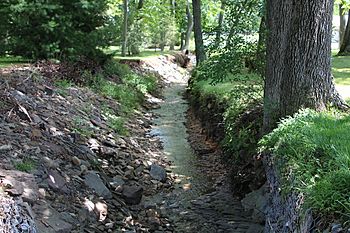Cabin Run, Columbia County, Pennsylvania facts for kids
Quick facts for kids Cabin Run |
|
|---|---|

Cabin Run looking downstream from Fowlersville Road
|
|
| Physical characteristics | |
| Main source | valley on Summer Hill in North Centre Township, Columbia County, Pennsylvania 840 to 860 feet (260 to 260 m) |
| River mouth | West Branch Briar Creek in North Centre Township, Columbia County, Pennsylvania 617 ft (188 m) |
| Length | 1.2 mi (1.9 km) |
| Basin features | |
| Progression | West Branch Briar Creek → Briar Creek → Susquehanna River → Chesapeake Bay |
| Basin size | 0.72 sq mi (1.9 km2) |
Cabin Run is a small stream in Columbia County, Pennsylvania. It flows into the West Branch Briar Creek. The stream is about 1.2 miles (1.9 km) long. It flows through a place called North Centre Township.
The area of land that drains into Cabin Run, called its watershed, is about 0.72 square miles (1.9 km2). The water in the stream is a little bit acidic. The ground under the stream is made of shale and siltstone.
Contents
Where Cabin Run Flows
Cabin Run starts in a valley on Summer Hill. This is in North Centre Township. First, it flows southeast for a short distance. Then, it turns south. It flows next to Cabin Run Road for a while.
After leaving the valley, the stream crosses Fowlersville Road. It turns southeast briefly, then turns south again. After flowing a bit more, it joins the West Branch Briar Creek. This meeting point is about 3.57 miles (5.75 km) before the West Branch Briar Creek ends.
Water Facts About Cabin Run
The amount of water flowing in Cabin Run changes a lot. It can be from 0.17 to 15.7 cubic feet per second. On average, it's about 0.53 cubic feet per second. The water temperature also changes. It can be as cold as 33.98 °F (1.10 °C) or as warm as 72.32 °F (22.40 °C).
The pH of Cabin Run's water is usually between 7.28 and 7.9. A pH of 7 is neutral, so Cabin Run is slightly alkaline. The water also has "total dissolved solids." These are tiny bits of minerals and other things dissolved in the water. The amount of these solids is usually between 42 and 106 parts per million. Sometimes, the stream has higher amounts of lead and nitrates.
A group called the Briar Creek Association for Watershed Solutions checked Cabin Run. They gave it a score of 5.6 out of 10. The stream scored well for things like nutrients and fish barriers. But it scored lower for how stable its banks are and the plants growing along its sides.
Land and Rocks Around the Stream
The land near where Cabin Run joins West Branch Briar Creek is about 617 feet (188 m) above sea level. Where Cabin Run begins, the land is higher. It's between 840 feet (260 m) and 860 feet (260 m) high.
A hill called Summer Hill is in the area that drains into Cabin Run. The ground near the mouth of Cabin Run is made of calcareous shale. This is a type of rock. The rest of the lower part of the stream's area is on regular shale. The upper parts of the stream are over siltstone.
The soil in some lower areas is called Zipp Series. This soil is a type of silt loam that doesn't drain water very well. The rocks under the lower parts of the stream are mostly from the Mahantango Formation. There's also a small strip of the Harrell Formation. The rocks under the upper parts are from the Trimmers Rock Formation. These rock layers formed a very long time ago, during the Devonian Period.
Cabin Run's Watershed Area
The watershed of Cabin Run covers an area of 0.72 square miles (1.9 km2). This is the smallest named watershed that feeds into Briar Creek.
Some important roads in the Cabin Run watershed include Fowlersville Road, Eckrote Road, and Hosler Road. The small community of Fowlersville is also located close to the stream.
History of Cabin Run
People tried to settle near Cabin Run a long time ago. In 1777, a man named Alexander Aikman came from New Jersey. He built a cabin by Cabin Run. But he went back to New Jersey later that year. Another person, Moses Van Campen, tried to live in the cabin. But Native Americans burned it down. Joseph Salmon also tried to settle there in 1777, but his cabin was burned in 1778.
Long ago, there was a mill on Cabin Run. This mill was used to grind plaster and food for farm animals.
The name "Cabin Run" comes from a legend. It's said that the stream was named after a cabin built there by two brothers, Joseph and Isaiah Solomon.

